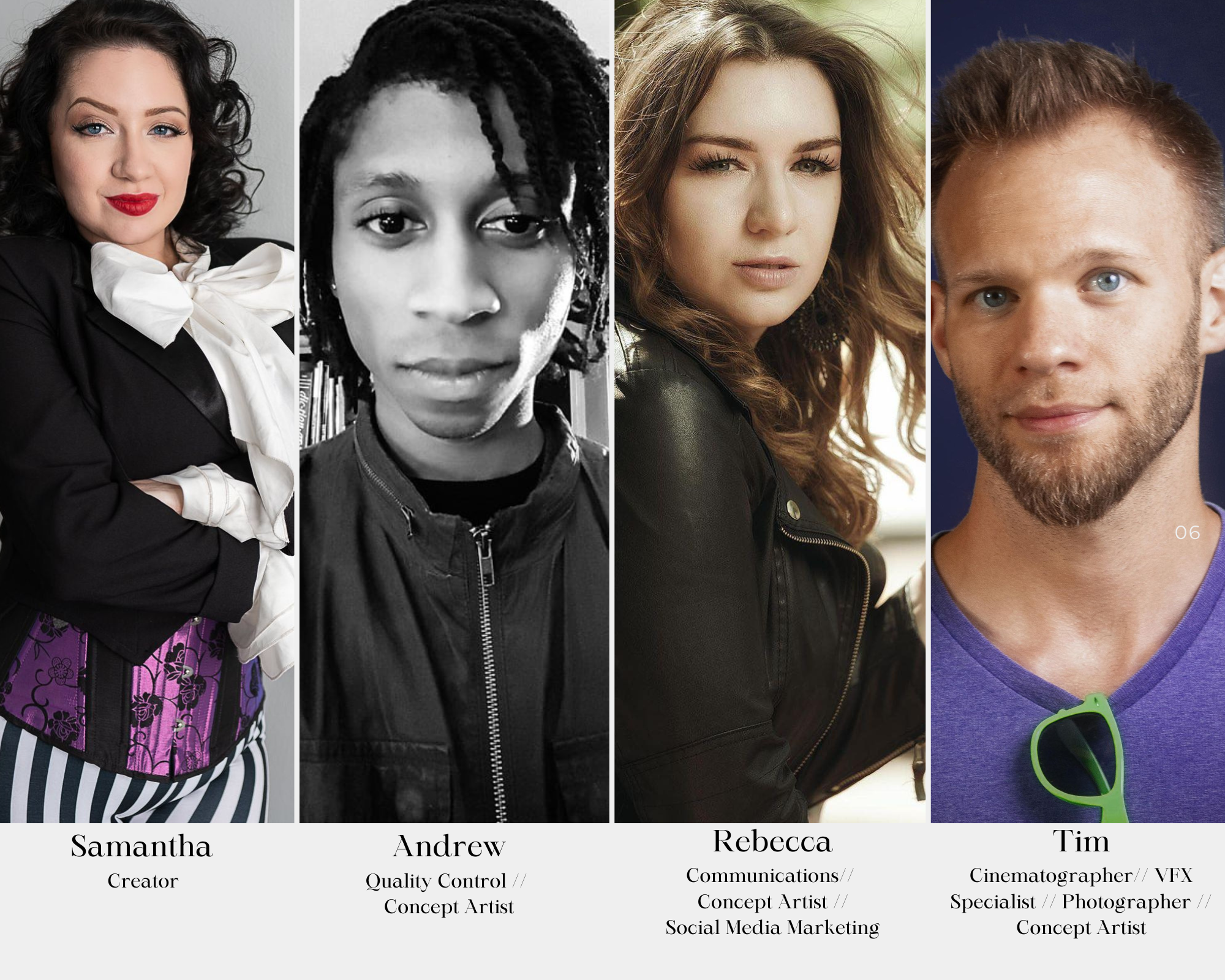The Empty Hourglass Project x Support The Arts

For those who don’t yet know how would you describe the project to a stranger on the street?
The Empty Hourglass Project is a safe space for those who have been impacted by mental illness, trauma, loss, addiction, suicide, and abuse to find healing through creative outlets and self-expression.
How did you put together your team and how was the process of working together recreating such emotional situations?
It all fell together pretty organically. Originally, I was planning on working with a myriad of photographers, models, etc (which still happened), but didn’t plan on having a core concept crew/team. Tim (Brosius) and Rebecca (Ellis) came to me with a concept of their own that they were planning on shooting (highlighting Rebecca’s story about self-
love and anxiety) and thought it would be a great addition to the book. Not too long after, I ended up asking them and our friend Andrew (Key) if they would be open to helping navigate all the stories and mashing our brains together to come up with concepts. It just all grew from there, really.
What effect did going thru everyone’s stories and developing their visuals have on you and your team?
I like to believe that it deepened our sensitivity, our compassion, towards humanity as a whole. A few stories were incredibly hard to read and they reminded us how everyone out there is struggling with something; even if you can’t see it.
From a creative standpoint, it made us better artists in terms of not only being able to visualize the final image, but to figure out the logistics and all the moving parts to make that image come together, and more importantly, to be able to have each other’s backs and work as a team (or one huge brain).
Was there ever a point where a story was hard to get through photographing?
From a logistical standpoint, somewhat. Sometimes shoots had to be rescheduled, or the original structure or design needed to be tweaked, etc. But from an emotional standpoint, it was a pretty smooth process. We were really fortunate to work with so many creative people who were understanding and respectful of the nature of the work
we were doing. Even if we had a moment where someone needed some time to step back or go at a slower pace, there was nothing but support and grace that was exhibited by everyone involved. I’m really grateful for such people.
Did you originally invision an interactive space and how has that impacted the project’s trajectory?
Originally, it was only supposed to be a book. But like with most things, my brain isn’t satisfied with simplicity, haha.
I was actually scrolling through Facebook one day and saw an image of an art install ona Time magazine cover, and the thought that we could use these stories as inspirationto create an immersive exhibit just hit.
When we were shooting each concept/story, and with the construction of the two exhibits, being able to re-imagine a world or retell a story where others (and yourself) are invited into it, where you can touch, see, hear so many different layers of that story, became one of the most rewarding parts. I absolutely want to continue getting exhibits
into public spaces, especially into schools, because I feel like it’s easier to talk about such overwhelming or “taboo” subjects when it’s presented in a creative manner.
What was the moment that made you decide you wanted this project to essentially be an interactive dairy as the tool for healing?
From the get-go. The very first story we (me and Josh Triggs) shot was my story. It was most definitely a test run to see how it would go, what the process was like, etc. It came out exactly as envisioned and I was so excited and inspired that it sort of “sealed the deal” that this could be doable, and now other people can be invited to be involved as well.
How long will the exhibit be up, do you hope to set up in other schools?
So the most recent exhibit was up from late August of 2023 – early January of 2024. Right now, we currently don’t have an exhibit up and running, but I’m in talks with a couple of places about installing one in the near future.
It’s definitely a goal to turn these exhibits into a program of sorts and “go on tour” (so to speak) and set up in various schools. I would especially appreciate being able to get it into more middle and high schools as well. The sooner we can have these conversations, the better.
Was there a moment where someone reacted to the project that gave you a feeling of fulfillment in the purpose of the project?
There were a handful of moments. One in particular came from a story contributor who expressed that the story she was sharing (touching on suicide) had been something she held in for so long and that she finally was able to make peace with her past/that part of her life. When we got around to shooting her story, she was involved in the image itself but also helping organize the shoot (locations, huge set piece, etc). It wasn’t until we were in the middle of shooting that she mentioned her attempt took place on the road right next to where we were. To be back in that (literal) same spot so many years later and being so deeply involved in the final outcome of it was very cathartic for her. It’s easy to get lost in the details of each shoot, but that moment always sticks out to me as a reminder why we do what we do.
How many issues are you hoping to publish or will you compile stories to later portray for as many issues as there’s interest to share?
Right now, we’re going to focus on completing our 2 nd volume/additional 25 stories. But the more that EHP grows, we hope to provide more outlets for people to share their stories (whether that be through publications, filmmaking, and more).
Is there anything you hope people take away from this project?
Resiliency. Compassion. I hope that it serves as a reminder of how much we can get survive and get through, even when it absolutely feels like we can’t. I hope that people remember we’re all affected, somehow, some way, and that it’s important to keep talking about mental health because if it’s not impacting you, it’s impacting someone you know
or someone close to a person in your circle. It doesn’t discriminate. The old adage “it’s okay not to be okay” is very true. It’s also okay to ask for help. I hope it (EHP) encourages people to do that.
Do you plan to create other merch to to go along with the book to offset costs?
Possibly in the future once we’ve grown a little more!
This projects is supported by msac, what is your take on the current state on arts in the school system?
Just as math, science, etc. are needed for a well-rounded education, I think art is just as, if not more, important. Without delving too deeply into the science behind art’s impact on mental health (since I’m not an expert. At least not yet anyway), in my own experience and those of friends and family, art opens you up to alternative and creative solutions in any area of life whether it be a relationship issue, something mathematical, etc. Group projects, theatre productions, and so on teach you how to be part of a team, social skills, how to talk to one another. It’s absolutely a positive tool to access pent up emotions and understand how to process your thoughts and what you’ve experienced. But art is also incredibly useful when it comes to everyday functioning and socializing and making connections with people and the world around you. De-funding arts programs doesn’t just cut off the access to creativity/creative pursuits, but it also cuts off the tools needed to understand how to interact with the world to the best of your ability and to make the most of your life and strengths
Since you have a goal of attaining your masters in art therapy, do you already have thoughts on ways to make integrating art into people’s healing process more accessible?
Of course, this is by no means a complete list, but (stating the obvious to start) continuing to provide art classes in schools or after school programs is a great way to keep arts accessible. Especially to those whose brains haven’t fully matured yet and are still open to radical ideas and possibilities.
Free weekly art programs for various communities (writing workshops, mandala creations, acting courses to process trauma, etc). Not just for schools, but prisons, mental health centers (inpatient and outpatient), rehab centers, and such. I’ve been fortunate to be involved with art therapy workshops that were free to the public for those struggling with grief, suicide attempt(s) and more, and have seen firsthand how having that community has made even the slightest impact on those suffering. Even installing interactive art stations at popular spots, such as bus stations or in the backs of Ubers/Lyfts, might encourage those who are struggling to begin seeking help and sharing their stories.
One goal I have for Empty Hourglass is to eventually run it as a completely free interactive arts program for those struggling with addictions, traumas, mental illness and more in a permanent, immersive space (or spaces, if we’re fortunate to do so).
How has this project provided healing for you?
Being able to connect with those who not only understand and can deeply relate to the topics we touch on, but aren’t afraid to explore those depths and actually put it out has certainly been healing. Receiving that validation that “what you’ve gone through is real, it happened, and it matters” makes a huge difference in someone’s recovery, I believe.
Besides that, there’s a sense of purpose. This isn’t just an interesting hobby or “for fun.”
There’s important work being done that, I want to believe, helps and positively impacts others.
https://www.emptyhourglassproject.com/

Empty Hourglass Team
Archives

Leave a Reply